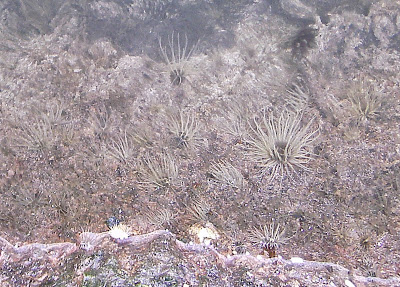After I first started monitoring Wellfleet Marina in 2011, I wrote a post on the striped anemone, Diadumene lineata, on docks in the North Harbor, noting that few other species were found (see December 2011 post). A monitoring study on MIS species along the New England coast reported that Diadumene was extremely tolerant to extremes in temperature, salinity, and water quality (Pappal et al, 2003). Interestingly, temperature and salinity readings in Wellfleet during the summer of 2011 appeared normal, similar to those in Provincetown. I did notice, however, that the turbidity of the water was much higher than that in Provincetown, and visibility was greatly reduced.
The following year, I learned more about the harbor when I coincidentally visited the harbor about 30 minutes before low tide. The North Marina was already drained of water, and, in the South Marina, the receding water under the docks was rapidly disappearing. I realized that the twice-daily exposure at low tide and high sediment levels were probably the most significant contributing factors to the distribution of species (see additional images in Footer at bottom of Blog).
High tidal variation is characteristic of the Gulf of Maine, and in the North Harbor, the shallow bay is filled and emptied during each tidal cycle. This variation has a positive effect on marine life (e.g., oyster beds) in that it brings in fresh seawater twice a day. At the highest tides, the harbor is filled and Duck Creek is a shallow bay. At the lowest tide, Duck Creek is drained and the marina is transformed into a mudflat. Tidal variation in the summer averages over 10 feet, and this July, the tidal variation peaked at over 14 feet.
The following year, I learned more about the harbor when I coincidentally visited the harbor about 30 minutes before low tide. The North Marina was already drained of water, and, in the South Marina, the receding water under the docks was rapidly disappearing. I realized that the twice-daily exposure at low tide and high sediment levels were probably the most significant contributing factors to the distribution of species (see additional images in Footer at bottom of Blog).
High tidal variation is characteristic of the Gulf of Maine, and in the North Harbor, the shallow bay is filled and emptied during each tidal cycle. This variation has a positive effect on marine life (e.g., oyster beds) in that it brings in fresh seawater twice a day. At the highest tides, the harbor is filled and Duck Creek is a shallow bay. At the lowest tide, Duck Creek is drained and the marina is transformed into a mudflat. Tidal variation in the summer averages over 10 feet, and this July, the tidal variation peaked at over 14 feet.
On the north marina, Diadumene lineata, a yellow sponge (keyed as Halichondria bowerbankia), and an occasional oyster have most of the floating docks to themselves. At high tide, sediment in the water produces a layer of sediment and organic matter on the sides of the floats. At low tide, the floats sink into the mudflat. This adds an additional layer of dark mud to the float. Most of the anemones are in the upper layer near the waterline.
On the South Marina, most of the docks are seasonal, and Molgula, algae, and distinctive color variations of Botryllus schlosseri form the dominant species on the sides of docks. Other species that are commonly observed are sea lettuce Ulva, filamentous green algae, an occasional Codium, and branched red algae such as Neosiphonia harveyi.
Satellite Views of Wellfleet Harbor at High and Low Tide
Tidal variation in Wellfleet Harbor taken from different satellite images of Wellfleet. Left, high tides. Right, mid-to-low tide. At the lowest low tides, the entire north estuary is drained.
View of the North Wellfleet Harbor at Low Tide
Evening low tide in the Duck Creek estuary on the North Side of Wellfeet Marina, September 16, 2012. The entire area is drained and converted into a mud flat of dark brown, wet sediment. At low tide, the docks rest partially submerged in sediment. This year, the marina was monitored at high tide and will be henceforth.
Diadumene Habitat on the Side of the Main Dock in the North Marina
Digital photos and enlarged details of Diadumene lineata on the North Marina docks (August, 2013). Diadumene lives in social groups distributed along the length of the docks right below the water line. Wellfleet was monitored at high time this summer. The floats were stratified into three regions: the upper, dry float above the water water (bottom of top image), a light brown zone containing sediment below the water line that is exposed at low tide, and a dark brown zone zone that sinks into the dark sediment at low tide (top of top image). Most of the anemones live in the light brown region, but a few individuals can also be found in the dark brown zone.
LINKS:
Pappal, A, J Pederson, JP Smith. Marine Invaders in the Northeast, 2003.
In this study, Diadumene was commonly found at Marinas in Naragansett Bay and Buzzards Bay and at certain locations in the Gulf of Maine.
Harbor Watch: Striped Anemone at Wellfleet Harbor. Features stereomicroscopic views of collected anemones.




